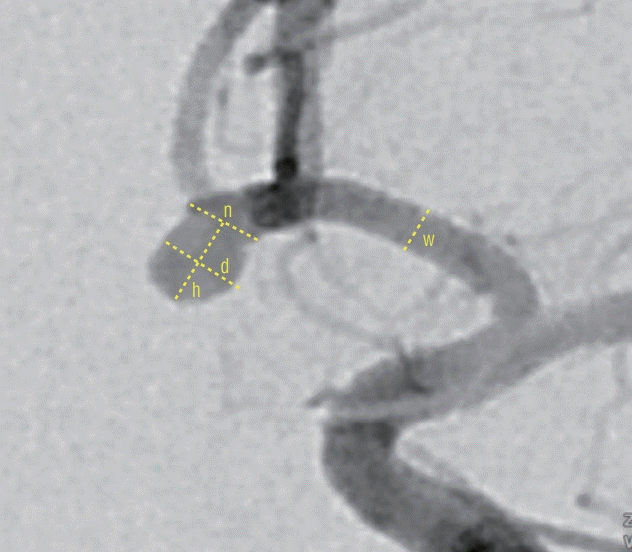1. Bonneville F, Sourour N, Biondi A. Intracranial aneurysms: an overview. Neuroimaging Clin N Am. 16:371–382. 2006.

2. Cebral JR, Castro MA, Burgess JE, Pergolizzi RS, Sheridan MJ, Putman CM. Characterization of cerebral aneurysms for assessing risk of rupture by using patient-specific computational hemodynamics models. AJNR Am J Neuroradiol. 26:2550–2559. 2005.
3. Chan V, Lindsay P, McQuiggan J, Zagorski B, Hill MD, O’Kelly C. Declining admission and mortality rates for subarachnoid hemorrhage in canada between 2004 and 2015. Stroke. 50:181–184. 2019.

4. Chen S, Mao J, Chen X, Li Z, Zhu Z, Li Y, et al. Association between body mass index and intracranial aneurysm rupture: a multicenter retrospective study. Front Aging Neurosci. 13:716068. 2021.

5. Choi JH, Park HS. The incidence and characteristics of patients with small ruptured aneurysms (<5 mm) in subarachnoid hemorrhage. J Korean Neurosurg Soc. 60:424–432. 2017.

6. Feigin VL, Rinkel GJ, Lawes CM, Algra A, Bennett DA, van Gijn J, et al. Risk factors for subarachnoid hemorrhage: an updated systematic review of epidemiological studies. Stroke. 36:2773–2780. 2005.
7. Grochowski C, Litak J, Kulesza B, Szmygin P, Ziemianek D, Kamieniak P, et al. Size and location correlations with higher rupture risk of intracranial aneurysms. J Clin Neurosci. 48:181–184. 2018.

8. Jeong YG, Jung YT, Kim MS, Eun CK, Jang SH. Size and location of ruptured intracranial aneurysms. J Korean Neurosurg Soc. 45:11–15. 2009.

9. Kang H, Ji W, Qian Z, Li Y, Jiang C, Wu Z, et al. Aneurysm characteristics associated with the rupture risk of intracranial aneurysms: a selfcontrolled study. PLoS One. 10:e0142330. 2015.

10. Kayembe KN, Sasahara M, Hazama F. Cerebral aneurysms and variations in the circle of willis. Stroke. 15:846–850. 1984.

11. Keedy A. An overview of intracranial aneurysms. Mcgill J Med. 9:141–146. 2006.

12. Krzyzewski RM, Tomaszewska IM, Lorenc N, Kochana M, Goncerz G, Klimek-Piotrowska W, et al. Variations of the anterior communicating artery complex and occurrence of anterior communicating artery aneurysm: A2 segment consideration. Folia Med Cracov. 54:13–20. 2014.
13. Marinković S, Kovacević M, Milisavljević M. Hypoplasia of the proximal segment of the anterior cerebral artery. Anat Anz. 168:145–154. 1989.
14. Medina LS, Bernal B, Ruiz J. Role of functional MR in determining language dominance in epilepsy and nonepilepsy populations: a bayesian analysis. Radiology. 242:94–100. 2007.

15. Murayama Y, Takao H, Ishibashi T, Saguchi T, Ebara M, Yuki I, et al. Risk analysis of unruptured intracranial aneurysms: prospective 10-year cohort study. Stroke. 47:365–371. 2016.
16. Perlmutter D, Rhoton AL Jr. Microsurgical anatomy of anterior cerebral anterior communicating recurrent artery complex. Surg Forum. 27:464–465. 1976.
17. Qin H, Yang Q, Zhuang Q, Long J, Yang F, Zhang H. Morphological and hemodynamic parameters for middle cerebral artery bifurcation aneurysm rupture risk assessment. J Korean Neurosurg Soc. 60:504–510. 2017.

18. Rinaldo L, McCutcheon BA, Murphy ME, Bydon M, Rabinstein AA, Lanzino G. Relationship of A1 segment hypoplasia to anterior communicating artery aneurysm morphology and risk factors for aneurysm formation. J Neurosurg. 127:89–95. 2017.

19. Rinaldo L, McCutcheon BA, Snyder KA, Porter AL, Bydon M, Lanzino G, et al. A1 segment hypoplasia associated with cerebral infarction after anterior communicating artery aneurysm rupture. J Neurosurg Sci. 63:359–364. 2019.

20. Rinkel GJ, Djibuti M, Algra A, van Gijn J. Prevalence and risk of rupture of intracranial aneurysms: a systematic review. Stroke. 29:251–256. 1998.

21. Suarez JI. Diagnosis and management of subarachnoid hemorrhage. Continuum (Minneap Minn). 21:1263–1287. 2015.

22. Tarulli E, Fox AJ. Potent risk factor for aneurysm formation: termination aneurysms of the anterior communicating artery and detection of A1 vessel asymmetry by flow dilution. AJNR Am J Neuroradiol. 31:1186–1191. 2010.

23. Ujiie H, Liepsch DW, Goetz M, Yamaguchi R, Yonetani H, Takakura K. Hemodynamic study of the anterior communicating artery. Stroke. 27:2086–2093. 1996.

24. Ujiie H, Sato K, Onda H, Oikawa A, Kagawa M, Takakura K, et al. Clinical analysis of incidentally discovered unruptured aneurysms. Stroke. 24:1850–1856. 1993.






 PDF
PDF Citation
Citation Print
Print




 XML Download
XML Download